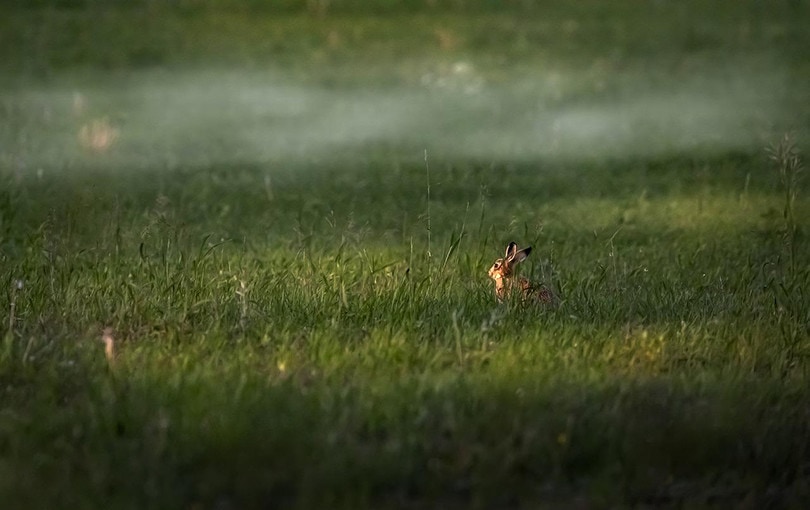How to Hunt Rabbits – 6 Basic Tips & Tricks
Last Updated on

There are quite a few types of rabbits out there: cottontails, snowshoe hares, European rabbits, jackrabbits—you name it. If you want to find them and successfully hunt them, you’ll need to read below and see our six tips on how to do it the right way.

How to Hunt Rabbits – 6 Basic Tips & Tricks
1. Research Wild Rabbit Behaviors

It might seem more than obvious, but many people don’t know the behaviors of wild rabbits and just randomly go into the woods to see what they come across. If you put yourself in the shoes of the rabbit—or feet, we should say—you’ll be able to know where they are and what they’re up to.
Rabbits can be found during any time of day, but you’re better off searching at dusk or dawn when they are most active, although they can be nocturnal based on where you live. One resource to educate yourself on their behaviors is a game camera. This enables you to see if rabbits are in the area, as well as watch the times of day that they are most active.
2. Don’t Use a Rifle or Pistol
Firing a standard rifle or handgun at a rodent of any kind will destroy its body and reduce the amount of meat you can successfully cook. Instead, grab a 12-gauge or 20-gauge shotgun for a better result that will preserve its meat and increase your likelihood to hit them. You can also try a bow or crossbow if that is permitted in your area.
3. Habitat

Rabbit homes consist mainly of low-lying vegetation or open, grassy areas that have lots of bushes they can shelter in. Meadows, forest openings, and piles of brush or branches are the best places to look, as they live here in abundance. You might also see them sneaking into gardens or below fruit-bearing plants and trees.
Do keep in mind that various species of rabbits have a camouflaged fur coat that blends in perfectly with trees, snow, and brush. Oftentimes, they may stand completely still if a human is nearby in order to stay unnoticed.
4. Scat
While you’re out searching for these critters in the woods or grassy areas, look out for piles of droppings that are about the size of a dime or penny. These are likely from a rabbit or hare, and we recommend you examine the moisture content of the scat. If it’s fresh, it will be moist and smell stronger, indicating that they aren’t too far away.
5. Tracks

Similar to our third step, you’ll want to watch for rabbit trails, which have a distinct “Y” pattern that can be seen for each leap they take. Their front tracks are long and narrow, with small back feet. It can differ if it is a hare, though, as they have a wider, boxier shape.
This can be tricky depending on the season, but tracking after a winter storm is always the best choice for finding footprints in the snow. Otherwise, you’ll likely only have luck if the trails are muddy from recent rainfall.
6. Stay Still
Remember, rabbits have eyes that protrude to the sides of their head, so they have a wide field of view, which will make it essential to stay out of their line of sight. It’s crucial that you set yourself up in a particular spot that shows fresh evidence of rabbits or hares or periodically stand still to listen for movement and scope out the area.
The most famous characteristic of a rabbit is its ears, and they are extremely sensitive to sound. You don’t want to spook them because, if you do, they can leap away in a heartbeat and you’ll only come home with dirt on your boots.
Conclusion
Rabbits are intelligent prey animals and are hard targets due to their size, speed, and mobility in the brush. There are some clever tactics you can put into practice that will up your chances of hitting your target. Our hope is that these six tips will get you into the wild and help bring back some dinner. Always obey the laws of your residency and stay safe by wearing bright orange. Good luck!
You might interested:
Featured Image Credit: SvenZiegler, Pixabay
About the Author Robert Sparks
Robert’s obsession with all things optical started early in life, when his optician father would bring home prototypes for Robert to play with. Nowadays, Robert is dedicated to helping others find the right optics for their needs. His hobbies include astronomy, astrophysics, and model building. Originally from Newark, NJ, he resides in Santa Fe, New Mexico, where the nighttime skies are filled with glittering stars.
Related Articles:
How to Collimate Binoculars: 9 Expert Tips
How to Clean a Rifle Scope: 8 Expert Tips
How to Choose Binoculars for Bird Watching: 10 Expert Tips
How to Clean a Refractor Telescope: Step-by-Step Guide
How to Clean a Telescope Eyepiece: Step-by-Step Guide
Monocular vs Telescope: Differences Explained (With Pictures)
What Is a Monocular Used For? 8 Common Functions
How to Clean a Telescope Mirror: 8 Expert Tips
